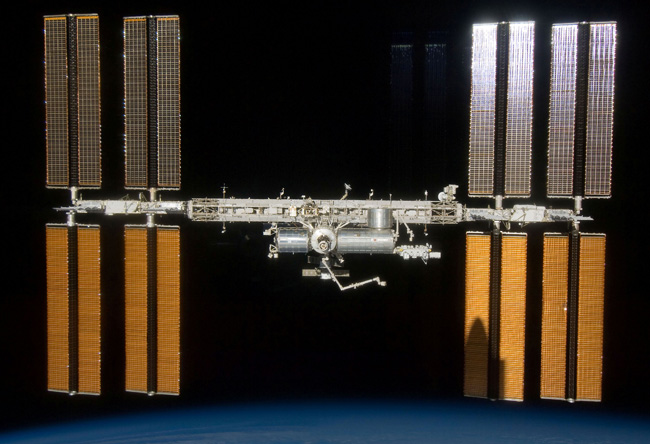Space Medicine
Today, Astronaut Michael Barratt talks about medicine in space. The University of Houston presents this series about the machines that make our civilization run, and the people whose ingenuity created them.
When we speak of medicine, we imagine applying it to a basic human physiology. What we know of physiology is incomplete; though it serves us rather well when we deal with normal human function and disease. But our physiology has developed within the gravity and atmosphere of one particular planet's surface.
The pressure and oxygen content of our air fuels our highly demanding oxygen-burning bodies. It defines they way our lungs function, the makeup of our blood, the action and efficiency of our muscles. Our posture, our gait, and the way we see sense our surroundings have all been formed by our vertical gravity field.
Just think about the way gravity defines a horizon and an upright posture. A line drawn between the center of the earth and our body's center of mass, along with a gravitational force of 9.8 meters-per-second-squared, gives our body weight. The word upright means we're oriented along that line with our heads held high.
When we fly in space, we take our atmosphere with us by mixing oxygen and nitrogen and regulating its pressure. But the main influence upon a body in earth orbit, where we've gained most of our flight experience, is weightlessness. That's because any orbiting body is in ceaseless freefall around the earth.
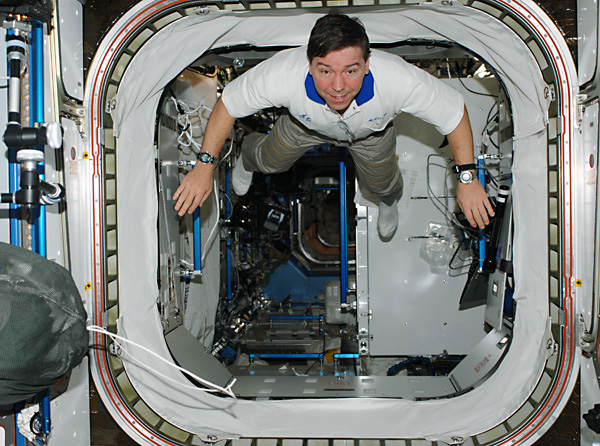
Before the first space flights, some asked if humans could survive without steady earth gravity. We actually do just fine in weightlessness. That makes sense when we consider the way we constantly re-orient our bodies during any day. We lie down, sit, and rise to stand ... Steady state on earth is not steady at all. Our blood flow, our lung function — all our bodily processes — constantly have to optimize. Weightlessness simply neutralizes these reorientations. It's the true steady state.
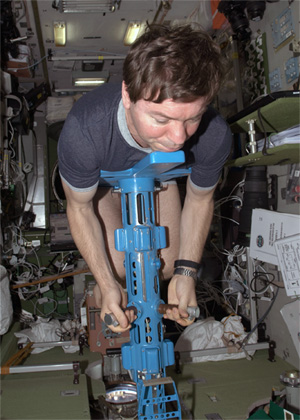
Mike Barratt "weighing" himself
But, functional as we are in weightlessness, our bodies undergo all kinds of predictable changes as they adapt to this new environment. Body fluids shift to the chest and head, blood volume decreases, muscle and bone lose mass and strength ... Our bodies seek a new equilibrium based on atmosphere, exercise, and diet. These adaptive changes become maladaptive only when we come back to Earth and the conditions that shaped us from the beginning.
Our perception of other-worldly intelligent life is given by science fiction — humanoids with comfortably similar form, size, and movement. (Never mind that most aliens speak English.) Wouldn't it be nice if all worlds had our gravity and atmosphere? Reality may be a lot less convenient for Hollywood, but it's far more interesting.
Human form and function will change as we keep moving outward into the solar system and beyond — colonizing worlds with different gravity and tailored atmospheres. And colonize we will. The zero-G adapted human becomes an extraterrestrial of sorts, as will those who adapt to these other worlds. And I can well imagine the day when terrestrial medicine becomes just another medical specialty.
I'm Michael Barratt for the University of Houston, where we're interested in the way inventive minds work.
Additional Notes:
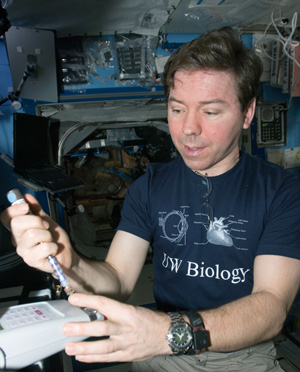
The human body undergoes a grand constellation of physiological changes when placed in a weightless environment. Some are annoying, lasting typically a few days before resolving; these include space motion sickness, nasal and sinus stuffiness from fluids shifting away from the lower extremities toward the chest and head, and lower back pain as the spine elongates against the ligaments between the vertebrae. Others are not perceived, and include decrease in circulating blood volume and red blood cell count, changes in the blood and air distribution in the lungs, and alterations in heart muscle mass and pumping function. Most of these changes are simply adaptive and serve to optimize function in this novel environment. Some, such as the loss of bone density and muscle mass, become maladaptive when returning to earth, where again the body must work against a gravity field. Always in the background is the accumulated radiation dose from being bathed in charged particles residing in low earth orbit; astronauts are classified as radiation workers for this reason. Although not perceived, this creates a theoretical risk for increased incidence of cancers.
This constellation of physiologic changes presents as a new background for the medical practitioner. A given medical problem might present quite differently, and returning a patient to their normal state or lab value may mean resuming a new setpoint quite different than the terrestrial norm.
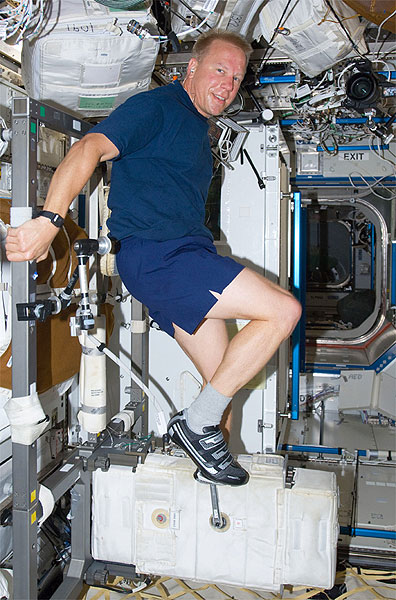
Tim Kopra on an ergometer
Crew members aboard the International Space Station exercise for over 2 hours each day mitigating the loss of bone and muscle, to ensure a speedy rehabilitation once back on earth and return to normal function. Put another way, you spend a good deal of time during your stay in orbit preparing to return to earth. But the zero-g adapted human is really quite remarkable, a three dimensional creature that flies accurately and effortlessly and handles large masses with dexterity. Given our one-g upbringing on the earth's surface and our ability to adapt to weightlessness, prolonged stays in fractional-g, such as the 1/6 g of the lunar surface and the 1/3 g of Mars will not be a problem. Combined with the habitat pressure and atmospheric makeup, each will have an attendant set of physiologic norms unique to that environment.
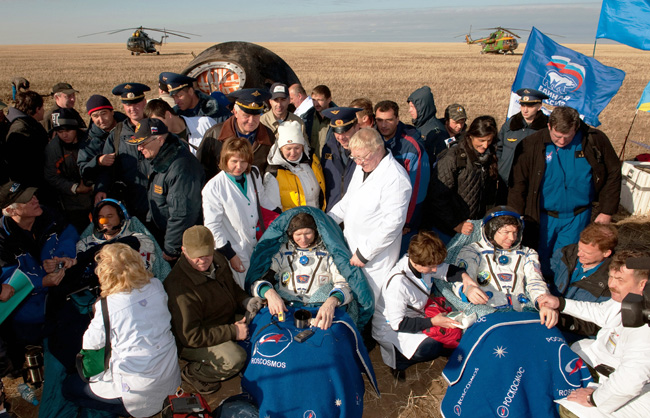
Crew members freshly returned from orbit aboard the Soyuz TMA-14 spacecraft, Oct 11th, 2009. From the left are spaceflight participant Guy Laliberte from Canada, Gennady Padalka from Russia, and Michael Barratt from the US. One must move slowly and carefully after 199 days in weightlessness, as the body readapts to gravity.
Michael Barratt is a NASA astronaut and physician, with specialties in internal and aerospace medicine. He came to the Johnson Space Center in 1991, where he worked for 9 years as a project physician and space flight surgeon. Working with the joint US/Russian programs involving the Space Shuttle and the Mir space station, Dr. Barratt was able to work with a new set of colleagues in the Russian space medical community. Selected as an astronaut in the class of 2000, he made his first flight in 2009 aboard a Russian Soyuz, and spent 199 days in flight during a tour of duty on the International Space Station. He remains active in the space medical community, serving as associate editor for space medicine for the journal Aviation, Space, and Environmental Medicine, and is senior editor of the text Principles of Clinical Medicine for Space Flight.
G. Clement, Fundamentals of Space Medicine. (Springer, 2005).
Principles of Clinical Medicine for Space Flight. (M. Barratt, S. Pool, editors) (New York: Springer-Verlag, 2008).
All photos are courtesy of NASA.
Long captions for the images above, in the order they appear:
Astronaut Michael Barratt hovers without touching any walls. The atmosphere in the ISS is kept near sea level pressure of 14.7 psi with the normal nitrogen/oxygen mix and a temperature around 22 C. A din of background noise is constant as fans circulate air, pumps move cooling fluids, and experimental systems racks hum.
Mike Barratt 'weighs in'. Astronauts typically lose bone and muscle. Tracking body weight gives a rough indication of the balance of exercise and diet. Since we have no weight in zero-g, body mass is determined using an oscillating platform with a known spring tension. Applying Newton's laws to the frequency gives the body mass.
Mike Barratt analyzing surface samples for evidence of bacterial contamination. The ISS is a world-class laboratory for investigation the effects of weightlessness and closed habitats. This particular experiment involves development of an assay that detects presence of harmful bacteria without having to wait days for culture results.
Astronaut Tim Kopra exercises on a cycle ergometer in the US laboratory module. Astronauts exercise over two hours a day to maintain aerobic fitness and strength. Aside from the physical benefits, daily exercise provides a tremendous psychological boost.
